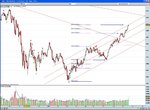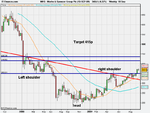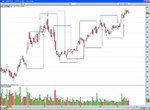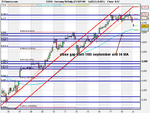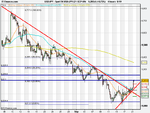G-20 Push on Banks Threatens Profits From Goldman to Barclays
Sept. 21 (Bloomberg) -- Global leaders meet this week seeking to deliver the broadest financial regulation overhaul since the 1930s, potentially threatening profits and stock prices of banks from Goldman Sachs Group Inc. to Barclays Plc.
President Barack Obama and his Group of 20 counterparts convene in Pittsburgh on Sept. 24-25 to cement a plan to force banks to curb leverage, hold more equity capital and keep a greater pool of assets that can be easily traded. Bankers’ pay will also top the agenda as officials try to hammer out an accord that will prevent a repeat of the worst crisis since the Great Depression.
By limiting the scope of banks to invest and trade, governments may check this year’s 22 percent gain in the Standard & Poor’s 500 Financial Index. That may be a price they’re willing to pay to prevent a repeat of the risk-taking that sparked the collapse of Lehman Brothers Holdings Inc. a year ago, a worldwide recession and taxpayer-funded bank rescues.
“Regulation will make banks less profitable by increasing the cost of doing business,” said Andrew Clare, a professor at Cass Business School in London and a former Bank of England official. “If banks are going to benefit from taxpayer largesse then they need to act in a way that doesn’t hurt taxpayers or the economy.”
The summit, which will also be attended by U.K. Prime Minister Gordon Brown, French President Nicolas Sarkozy and Chinese President Hu Jintao, will also discuss how to sustain the economic recovery, avoid protectionism, improve accountancy and revamp governance of the International Monetary Fund.
Voter Disquiet
Leaders travel to the Steel City amid voter disquiet after governments used public money to bail out banks only to see many of them quickly return to profit and resume setting aside billions for bonuses. Seventy-three percent of U.K. voters polled this month by YouGov wanted a tax imposed on all bonuses over 10,000 pounds. A Gallup poll in June showed that 59 percent of Americans wanted action to curb executive pay.
Under consideration: forcing banks to augment their capital buffers to better account for risk, retain more earnings and satisfy a leverage ratio, which measures equity as a proportion of total holdings. They may also consider a proposal to tie pay to capital levels from Financial Stability Board Chairman Mario Draghi.
“There has been a culture that rewards short-term thinking, that used leverage to take exorbitant risks that were unsustainable for the system as a whole,” Obama said in a Sept. 14 interview with Bloomberg Television. “That’s the culture I think that we’ve got to reverse.”
Crackdown
The crackdown could lower profitability by a third at Goldman, Barclays and Deutsche Bank AG’s investment bank, JPMorgan Chase & Co. analysts led by Kian Abouhossein said in a Sept. 9 report.
Deutsche Bank’s return on equity will probably tumble the most among the world’s largest investment banks, falling to 6.7 percent in 2011 from 10 percent today, the analysts said. Goldman’s return on equity will decline by 4.4 percentage points and Barclays’ by 4.3 points.
“The amendments to capital requirements will clearly affect the activities of banks in their trading books and securitizations,” said Alessandra Mongiardino, a London-based analyst at Moody’s Investors Service.
Spokespeople for Goldman, Deutsche bank and Barclays declined to comment.
Stock Drop?
Investors may suffer if financial companies have to issue more equity, said Charles Goodhart, a former Bank of England official and now a professor at the London School of Economics.
“Banks will have to raise more capital by issuing more equity so existing stocks will generally go down,” Goodhart said. The IMF estimated in April that U.S. and European banks would need $875 billion in extra capital.
To be sure, Goldman has demonstrated that higher capital and lower leverage don’t always mean reduced profits.
The company, which set aside a record $11.4 billion for compensation and benefits in the first half, cut its ratio of assets-to-common equity to 16 times in the second quarter from 26 times a year earlier. Goldman still set a new Wall Street profit record this year, making $3.4 billion on $13.8 billion of revenue in the three months that ended in June.
The new rules will probably also take years to go into effect, with U.S. Treasury Secretary Timothy Geithnerproposing that new capital requirements be in place by the end of 2012.
Lehman Demise
Since the demise of Lehman, some banks have already cut leverage, boosted capital by selling stock, and set aside a larger pool of easy-to-sell, or “liquid,” assets.
Morgan Stanley, the sixth-biggest U.S. bank by assets, raised $6.92 billion through stock sales in May and June and cut its ratio of total assets-to-common equity to 18.3 times at the end of June from 30.9 times a year earlier. Barclays’ so-called surplus liquidity jumped to 88 billion pounds ($145 billion) at the end of June from 36 billion pounds six months earlier.
“Banks have already changed so substantially that it’s unlikely the G-20 can impose a further pinch in terms of beefing up liquidity or reducing leverage,” said Simon Gleeson, a regulatory lawyer at Clifford Chance LLP, the second-biggest law firm, in London.
Any agreement on capital buffers could see European banks as the biggest losers, which could provoke the ire of Sarkozy and German Chancellor Angela Merkel, who faces elections on Sept. 27. The region’s banks may have to sell more stock than U.S. rivals to satisfy new capital rules having relied on so- called hybrid securities to meet the current requirements.
European Penalty?
“It would be paradoxical if European banks were to be penalized in terms of competition against U.S. banks, given that the crisis originated in the U.S.,” says Baudouin Prot, chief executive officer of BNP Paribas SA, France’s largest bank, at the French Senate Finance Committee in Paris on Sept. 16. He said a leverage ratio would be “extremely difficult” to introduce.
Merkel and Sarkozy have campaigned for the G-20 to focus instead on bonuses, arguing excessive executive pay played a role in triggering the crisis. The summit may fall short of “high expectations,” Merkel said Sept. 19.
The risk for politicians trying to persuade voters they haven’t let bankers off the hook is that the financial industry eventually finds a way around the regulatory revamp.
“We aren’t doing anything significant so far, and the banks are pushing back,” said Nobel laureate Joseph Stiglitz, a professor at Columbia University. “The leaders of the G-20 will make some small steps forward, given the power of the banks” and “any step forward is a move in the right direction.”
The G-20 accounts for about 85 percent of the world economy and the Pittsburgh talks will the third summit of its leaders in the past year. Its members are Argentina, Australia, Brazil, Canada, China, France, Germany, India, Indonesia, Italy, Japan, South Korea, Mexico, Russia, Saudi Arabia, South Africa, Turkey, the U.S., the U.K. and the European Union.

